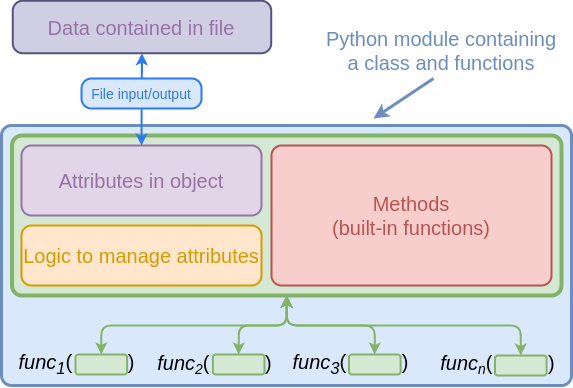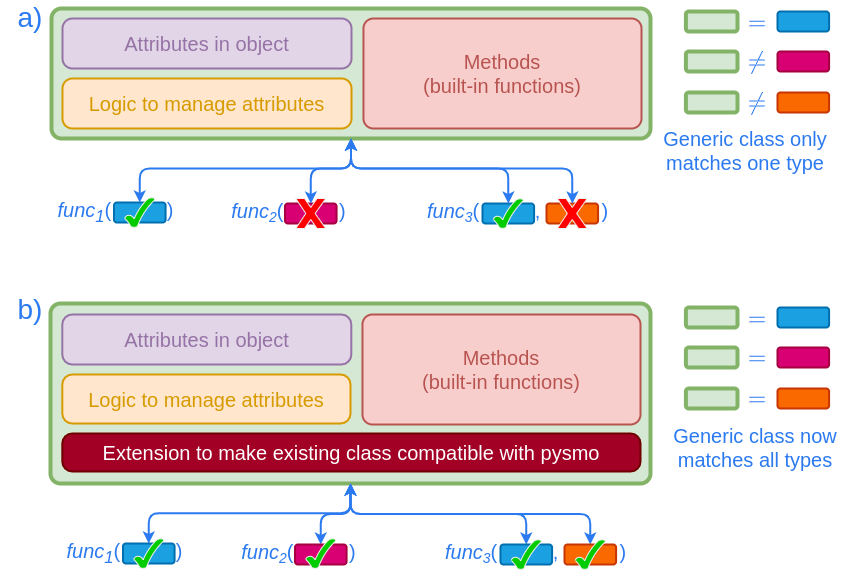More on Types#
What is (or isn't) a type?#
In short, a pysmo type should represent something that can (for the most part) be independently measured or observed, rather than being derived from some other type of data. The aim of this simple rule is to prevent ambiguous relationships between class attributes leading to inconsistencies creeping into data. For example, one might decide to define a class for station and event locations, together with the distance and azimuth between the two locations. Such a class may look something like this:
from some_library import calc_distance, calc_azimuth, calc_eve_coords # (1)!
class Example:
def __init__(self, stat_coords, eve_coords, distance, azimuth): # (2)!
self._stat_coords = stat_coords
self._eve_coords = eve_coords
self._distance = distance
self._azimuth = azimuth
@property
def stat_coords(self):
return self._stat_coords
@stat_coords.setter
def stat_coords(self, value): # (3)!
self._stat_coordes = value
self._distance = calc_distance(self._stat_coords, self._eve_coords)
self._azimuth = calc_azimuth(self._stat_coords, self._eve_coords)
@property
def eve_coords(self):
return self._eve_coords
@eve_coords.setter
def eve_coords(self, value): # (4)!
self._eve_coords = value
self._distance = calc_distance(self._stat_coords, self._eve_coords)
self._azimuth = calc_azimuth(self._stat_coords, self._eve_coords)
@property
def distance(self):
return self._distance
@distance.setter
def distance(self, value): # (5)!
self._distance = value
self._eve_coords = calc_eve_coords(
self._stat_coords, self._distance, self._azimuth
)
@property
def azimuth(self):
return self._azimuth
@azimuth.setter
def azimuth(self, value): # (6)!
self._azimuth = value
self._eve_coords = calc_eve_coords(
self._stat_coords, self._distance, self._azimuth
)
some_libraryis just a bit of pseudo code. For this example we just assume it is some real library that provides us with functions to use in our class.- We assume we initialise an instance with reasonable data, but should probably add some tests to verify if the values actually make sense...
- We assume the event coordinates stay the same when we change the station coordinates and recalculate distance and azimuth.
- We assume the station coordinates stay the same when we change the event coordinates and recalculate distance and azimuth.
- We assume the station coordinates and azimuth stay the same when we change distance and recalculate event coordinates.
- We assume the station coordinates and distance stay the same when we change azimuth and recalculate event coordinates.
It appears then that such a class could certainly be implemented, but we also see a few potential shortcomings:
- We need to take into account that every time an attribute changes, others need to be recalculated. Moreover, we need to decide which attributes are more important than others when deciding which ones to change to maintain consistent data.
- It is not a given that the calculations are always performed the same way (e.g. when using different reference Earth models for distance and azimuth calculations).
- What if the data we use to create a new instance of this class aren't entirely sensible? If they are completely wrong we will probably notice, but if they are off only by a small margin (e.g. due to being calculated elsewhere with a different model), one might never notice!
Because of these problems, there will never be pysmo type that has the same structure as the above class! Instead we would either opt for a type consisting of only coordinates, or one coordinate together with distance and azimuth:
from pysmo import Location
from typing import Protocol, runtime_checkable
# Option 1
@runtime_checkable
class StationEvent(Protocol):
@property
def stat_coords(self) -> Location:
...
@stat_coords.setter
def stat_coords(self, value: Location) -> None:
...
@property
def eve_coords(self) -> Location:
...
@eve_coords.setter
def eve_coords(self, value: Location) -> None:
...
# Option 2
@runtime_checkable
class StationDistAzi(Protocol):
@property
def stat_coords(self) -> Location:
...
@stat_coords.setter
def stat_coords(self, value: Location) -> None:
...
@property
def distance(self) -> float:
...
@distance.setter
def distance(self, value: float) -> None:
...
@property
def azimuth(self) -> float:
...
@azimuth.setter
def azimuth(self, value: float) -> None:
...
The attributes used in both protocol classes are independent, and they even could be used
with the Example class:
>>> my_example = Example(stat_cords, eve_coords, distance, azimuth)
>>> isinstance(my_example, StationEvent)
True
>>> isinstance(my_example, StationDistAzi)
True
Me must keep in mind here, that using protocol classes in this way does not magically
remove the problems with the Example class discussed above. It is conceivable, for
example, that the same instance of Example could be accessed via both StationEvent
and StationDistAzi simultaneously. Thus the dependencies between the Example
attributes are still a concern. While the attributes within StationEvent and
StationDistAzi may appear independent, the two types as a whole are not. It is
therefore a bad idea to define new types for pysmo with attributes that may not be
independent. Here we would choose either StationEvent or StationDistAzi to become
new pysmo types, but never both.
Note
The StationEvent and StationDistAzi types only serve as examples to illustrate
the problems that arise from dependencies between attributes. Pysmo types are
not about simplifying existing generic classes. When considering adding a new
type to pysmo, the starting point is always the type itself. Adding or modifying
the classes that hold the actual data comes afterwards. Remember that the
motivation for pysmo types stems from the idea that, while it makes sense to
group certain attributes together for storage, grouping them together for
processing in the same way often does not. Consequently neither of the above
types would realistically be considered for inclusion in pysmo!
Compatibility with Generic Classes#
A typical workflow using any kind of data consists of first reading those data into a Python object, and then working with the attributes and methods provided by the object. When reading from a file, the attributes often mirror the way the data are organised within the file. They are manipulated via the built-in methods or extra functions that use the entire object as input.

So if the data as described by the file format were to contain a variable called delta
for storing the sampling rate, the same data will likely be present as an attribute
called deltain the Python object. Besides the data, the Python object also needs to
incorporate logic to ensure the formatting and behaviour remains consistent with the
original file format. This is not only to be able to write back to the file, but also
because some variables might not be independent (see above).
These kinds of Python classes can be quite sophisticated, and often become the centrepieces of Python packages. They may even be capable of reading and writing to several different file formats. As one might imagine, writing and maintaining these classes is a lot of work, and it does not make much sense to create yet another one for pysmo.
In order to make use of these existing classes, we must ensure compatibility with the pysmo types. While some types may work out of the box with an existing class, it is usually necessary to modify the class to work with pysmo types. Crucially, this requires only a fraction of work compared to writing a data class from scratch.
